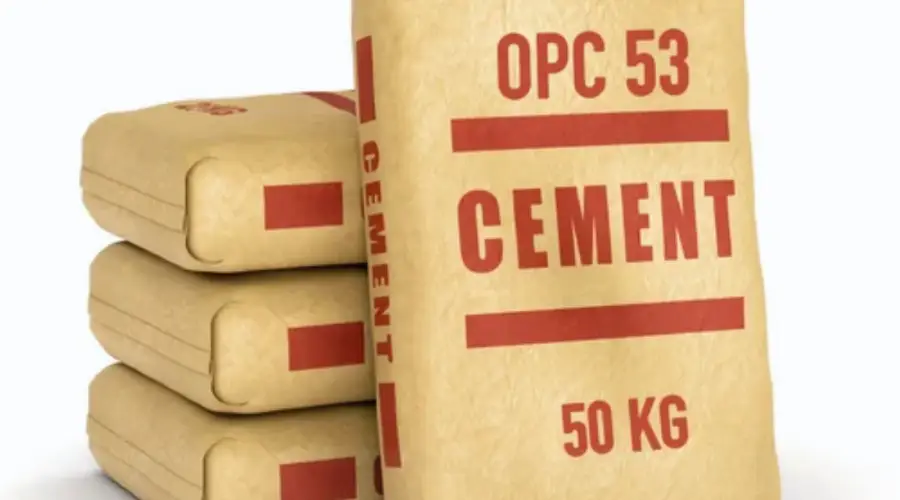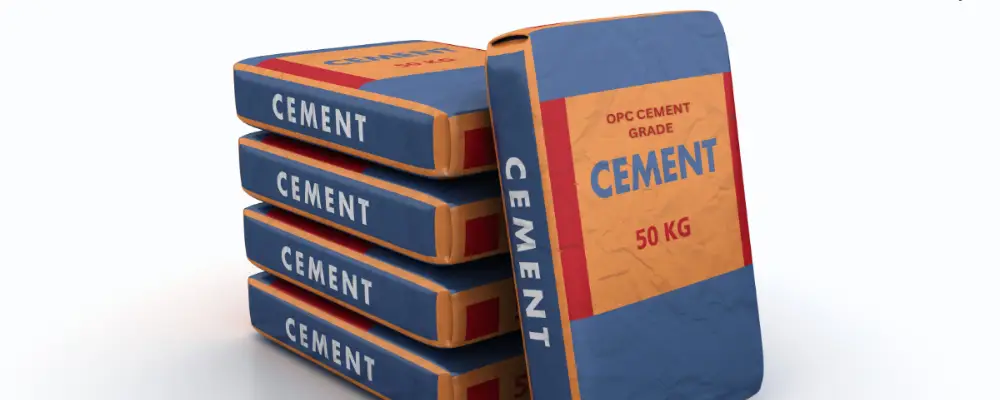An essential substance that is widely utilised as a binding agent in buildings all over the world is cement. The need for efficient binding agents has increased as architectural requirements and trends have changed. Ordinary Portland Cement (OPC), Portland Slag Cement, and Portland Pozzolana Cement are common varieties of enhanced binding agents that have unique qualities to improve the building process.
Achieving the intended building results depends on choosing the right kind of cement based on project specifications. This blog offers a full introduction to Ordinary Portland Cement, studying its numerous grades and their unique purposes. Furthermore, it offers a thorough summary of the traits of the various cement grades in the market, assisting you in making defensible choices for your construction needs.
What is the OPC Cement Composition?
Clinker, gypsum, and a small percentage of other minerals are the main ingredients of OPC cement. Cement-like properties of clinker can be achieved by heating limestone to high temperatures with other materials that cause chemical reactions. The several properties of OPC cement include high compressive strength, good working capacity, and longevity. Tight deadlines can be effectively achieved by employing OPC cement in the construction process.
What are the Different Grades of OPC Cement?
The grade of the binding agent can be determined by its compressive strength after four weeks of the curing period. The cement’s suitability for a certain construction project is also determined by its grade.
You can determine the concrete’s compressive strength by applying heavy load or pressure on the concrete. You get to know about the ability of the concrete to bear heavy loads or pressure without deforming or cracking. Megapascals (MPa) or Newtons per square millimetre (N/mm2) are the units of measurement.
| S.No | Grade of OPC | Compressive Strength | Measurement Unit | Explanation |
| 1 | 33 | 33 N/mm² | N/mm² or MPa | Indicates the cement’s ability to bear 33 N/mm² of load after four weeks of curing. |
| 2 | 43 | 43 N/mm² | N/mm² or MPa | Denotes a compressive strength of 43 N/mm² after four weeks of curing. |
| 3 | 53 | 53 N/mm² | N/mm² or MPa | Determines a compressive strength of 53 N/mm² at four weeks of curing. |
33 Grade
The main applications for 33-grade cement are in general buildings, where a modest level of strength is enough. After four weeks of curing, it offers a minimum compressive strength of 33 MPa or N/mm². This grade is not advised for structural components or projects needing great strength, but it is perfect for non-structural uses including flooring, brickwork, plastering, and other applications.
When it comes to cement particle size, OPC 33 has 225 m²/kg of fineness. The OPC grade 33 must satisfy the specific requirements of the Indian Standard (IS) 269:2015.
Characteristics of 33 Grade
| S.No | Characteristics | Details |
| 1 | Compressive Strength | Grade 33 usually has a compressive strength of 33 MPa, after four weeks of curing. |
| 2 | Setting Time | Exhibits a moderate setting time, suitable for various construction scenarios. |
| 3 | Durability | Known for its durability in standard conditions. |
| 4 | Common Applications | Ideal for non-load-bearing structures in residential buildings.Frequently used in projects where strength is not the main consideration. |
43 Grade
Building projects which require greater strength to achieve can be suggested for using 43-grade cement. After 28 days of curing, it provides a minimum compressive strength of 43 MPa with a fineness of 225 m²/kg. For load-bearing applications such as precast concrete components and reinforced concrete structures, this grade is perfect. It can withstand greater stress levels and offers improved durability. The basic specifications for creating the OPC 43 grade must match the specifics outlined in the Indian Standard IS 269:2015.
Characteristics of 43 Grade
| S.No | Characteristics | Details |
| 1 | Compressive Strength | With the capacity to bear moderate loads, grade 43 has a compressive strength of 43 MPa, following four weeks of the curing process. |
| 2 | Setting Time | Enables efficient handling during construction due to its balanced setting time. |
| 3 | Durability | Offers improved durability compared to grade 33. |
| 4 | Best-suited Applications | Suitable for commercial structures with moderate to high load-bearing requirements.Frequently utilised in highways, bridges, and other infrastructure projects.Used in building residential structures that require higher strength than Grade 33. |
43-S Grade
Railway sleepers are made from a particular type of Ordinary Portland Cement known as 43-S or 43 Sleeper Grade. The supports that the rails are mounted on are called railway sleepers, and they carry the weight of passing trains. The ballast, which consists of tiny rocks positioned underneath the sleepers, subsequently receives this load. With a fineness of 370 m²/kg, 43-S grade cement is perfect for building sturdy and long-lasting sleepers.
Characteristics of 43-S Grade
| S.No | Characteristics | Details |
| 1 | Compressive Strength | As it is best suitable for railway sleepers, 43-S Grade cement achieves a minimum compressive strength of 43 MPa after four weeks of curing. |
| 2 | Setting Time | It has a controlled setting time, allowing for easy handling and sufficient workability during construction. |
| 3 | Durability | Offers higher durability compared to lower-grade cement, suitable for exposure to moderate environmental conditions. |
| 4 | Fineness | This grade typically has a fineness of 370 m²/kg, ensuring smooth consistency in the mix. |
| 5 | Applications | Ideal for high-strength applications like railway sleepers. |
53 Grade

A high-strength OPC that is frequently utilised in projects requiring sturdy concrete is 53-grade cement. After four weeks of the curing process, its minimum compressive strength is 53 MPa. For long-span structures like bridges, large buildings, and heavy-duty industrial projects, this grade is perfect. IS 269:2015 specifies 53-grade manufacturing, chemical, and physical criteria with a fineness of 225 m²/kg.
Characteristics of 53 Grade
| S.No | Characteristics | Details |
| 1 | Compressive Strength | One of the strongest OPC grade cements is Grade 53, which helps to achieve a high compressive strength of 53 MPa. Perfect for applications requiring extreme strength, such as high-rise structures and bridges. |
| 2 | Setting Time | Sets relatively quickly, requiring efficient construction practices. Suitable for time-sensitive projects. |
| 3 | Durability | It is well-known for being extremely resilient to adverse environmental conditions and is long-lasting. Perfect for infrastructure projects exposed to extreme weather or heavy loads. |
| 4 | Applications | Ideal for high-strength applications like structural components of multistorey buildings. |
53-S Grade
Railway sleepers are made with a special type of OPC 53 cement known as 53 sleeper grade (53-S). For optimal properties, it contains magnesium, tricalcium silicate, and tricalcium aluminate with a fineness of 370 m²/kg.
Characteristics of 53-S Grade
| S.No | Characteristics | Details |
| 1 | Compressive Strength | 53-S Grade cement offers a compressive strength of 53 MPa after 28 days, ensuring high durability and load-bearing capacity. |
| 2 | Fineness | Has a fineness of 370 m²/kg, providing a smooth mix and improved performance. |
| 3 | Composition | The 53-S grade contains specific amounts of magnesia, tricalcium aluminate, and tricalcium silicate, which are essential for railway sleeper applications. |
| 4 | Durability | The 53-S grade cements are specially designed to withstand heavy loads and vibrations from train movements. |
| 5 | Applications | Ideal for manufacturing railway sleepers and other infrastructure requiring high strength and durability. |
Conclusion
As we discussed above, different grades of cement can be utilised for specific construction projects. From residential projects to infrastructure projects, the choice of building materials is crucial in getting the desired outcome of the construction project. These enhanced grades of binding agents can withstand harsh weather conditions and endure the test of time.
FAQ’s
OPC is a versatile type of Portland cement that is ideal for normal construction when the unique characteristics of other cement types are not needed. It is frequently utilised in situations when the cement or concrete is not subjected to special elements, including sulphate attack from water or soil or an extreme rise in temperature brought on by heat during hydration.

